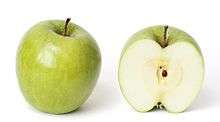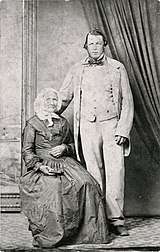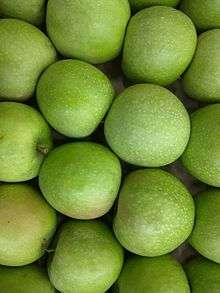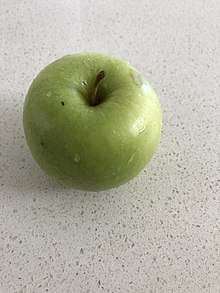Granny Smith
The Granny Smith is a tip-bearing apple cultivar, which originated in Australia in 1868.[1] It is named after Maria Ann Smith, who propagated the cultivar from a chance seedling. The tree is thought to be a hybrid of Malus sylvestris, the European wild apple, with the domesticated apple Malus pumila as the polleniser.
| Malus 'Granny Smith' | |
|---|---|
 | |
| Hybrid parentage | Thought to be Malus pumila × M. sylvestris |
| Cultivar | 'Granny Smith' |
| Origin | Maria Ann Smith Australia, 1868 |
The fruit is hard, with a light green skin and crisp, juicy flesh. The flavour is tart and acidic. It remains firm when baked, making it a very popular cooking apple[2] used in pies, where it can be sweetened. The apple goes from being completely green to turning yellow when overripe.[3]
It is claimed to be the third most popular apple in America by the US Apple Association.[4]
The Granny Smith was one of four apples honored by the United States Postal Service in a 2013 set of four 33¢ stamps commemorating historic strains, joined by Northern Spy, Baldwin, and Golden Delicious.[5]
History

The Granny Smith Cultivar originated in Eastwood, New South Wales, Australia (now a suburb of Sydney) in 1868. Its discoverer, Maria Ann Smith, had emigrated to the district from Beckley, East Sussex in 1839 with her husband Thomas.[6] They purchased a small orchard in the area in 1855-1856 and began cultivating fruit, for which the area was a well known centre in colonial Australia. Smith had eight children and was a prominent figure in the district, earning the nickname "Granny" Smith in her advanced years.[7]
The first description of the origin of the Granny Smith apple was not published until 1924. In that year, Farmer and Settler published the account of a local historian who had interviewed two men who had known Smith. One of those interviewed recalled that, in 1868, he (then twelve years old) and his father had been invited to Smith's farm to inspect a chance seedling that had sprung near a creek. Smith had dumped there, among the ferns, the remains of French crab-apples that had been grown in Tasmania.[8] Another story recounted that Smith had been testing French crab-apples for cooking, and, throwing the apple cores out her window as she worked, had found that the new cultivar had sprung up underneath her kitchen windowsill. Whatever the case, Smith took it upon herself to propagate the new cultivar on her property, finding the apples good for cooking and for general consumption.[9] Having "all the appearances of a cooking apple," they were not tart but instead were "sweet and crisp to eat."[6] She took a stall at Sydney's George Street market, where the apples stored "exceptionally well and became popular" and "once a week sold her produce there."[6]
Smith died only a couple of years after her discovery (in 1870), but her work had been noticed by other local planters. Edward Gallard was one such planter, who extensively planted Granny Smith trees on his property and bought the Smith farm when Thomas died in 1876. Gallard was successful in marketing the apple locally, but it did not receive widespread attention until 1890. In that year, it was exhibited as "Smith's Seedling" at the Castle Hill Agricultural and Horticultural Show, and the following year it won the prize for cooking apples under the name "Granny Smith's Seedling." The apple was so highly successful that the following year, many were exhibiting Granny Smith apples at horticultural shows.[7]
In 1895, the New South Wales Department of Agriculture recognised the cultivar and had begun growing the trees at the Government Experimental Station in Bathurst, New South Wales, recommending the gazette its properties as a late-picking cooking apple for potential export. Over the following years the government actively promoted the apple, leading to its widespread adoption.[8] Its worldwide fame grew from the fact that it could be picked from March and stored till November. Enterprising fruit merchants in the 1890s and the 1900s experimented with methods to transport the apples overseas in cold storage. Because of its excellent shelf life, the Granny Smith could be exported long distances and most times of the year, at a time when Australian food exports were growing dramatically on the back of international demand. Granny Smiths were exported in enormous quantities after the First World War, and by 1975, 40 percent of Australia's apple crop was Granny Smith.[9] By this time, it was being grown intensely elsewhere in the Southern Hemisphere, as well as in France and the United States. The advent of the Granny Smith apple is now celebrated annually in Eastwood with the Granny Smith Festival.
Properties
| Nutritional value per 100 g (3.5 oz) | |
|---|---|
| Energy | 218 kJ (52 kcal) |
13.81 g | |
| Sugars | 10.39 g |
| Dietary fiber | 2.4 g |
0.17 g | |
0.26 g | |
| Vitamins | Quantity %DV† |
| Thiamine (B1) | 1% 0.017 mg |
| Riboflavin (B2) | 2% 0.026 mg |
| Niacin (B3) | 1% 0.091 mg |
| Pantothenic acid (B5) | 1% 0.061 mg |
| Vitamin B6 | 3% 0.041 mg |
| Folate (B9) | 1% 3 μg |
| Vitamin C | 6% 4.6 mg |
| Minerals | Quantity %DV† |
| Calcium | 1% 6 mg |
| Iron | 1% 0.12 mg |
| Magnesium | 1% 5 mg |
| Phosphorus | 2% 11 mg |
| Potassium | 2% 107 mg |
| Zinc | 0% 0.04 mg |
| |
| †Percentages are roughly approximated using US recommendations for adults. Source: USDA Nutrient Database | |
Seedling apples are genetically variable. They are often poor in quality, and varieties do not come true from seed. To preserve the exact genetic variation, grafting is the usual method of propagation (and cuttings are sometimes used). All the Granny Smith apple trees grown today are clones from the original Smith tree in Sydney.[10]
Granny Smith apples are light green in colour. They are popularly used in many apple dishes, such as apple pie, apple cobbler, apple crumble, and apple cake. They are also commonly eaten raw as table apples, and at least one company (Woodchuck Hard Cider) makes Granny Smith varietal cider.
It is moderately susceptible to fire blight and is highly prone to scab,[11] powdery mildew, and cedar apple rust.
Granny Smith is much more easily preserved in storage than other apples, a factor which has greatly contributed to its success in export markets. Its long storage life has been attributed to its fairly low levels of ethylene production, and in the right conditions Granny Smiths can be stored without loss of quality for as long as a year. This cultivar needs fewer winter chill hours and a longer season to mature the fruit, so it is favoured for the milder areas of the apple growing regions. However, they are susceptible to superficial scald and bitter pit. Superficial scald may be controlled by treatment with diphenylamine before storage.[12] It can also be controlled with low-oxygen storage.[13] Pit can be controlled with calcium sprays during the growing season and with postharvest calcium dips.[14]
Health benefits

Granny Smith is one of several apple cultivars that are high in antioxidant activity, and they have the highest concentration of phenols amongst the apple breeds.[15] Some sources recommend Granny Smiths (among other apples) as a particularly efficient source of antioxidants, particularly the flavonoids cyanidin and epicatechin, especially if eaten with the skin intact.[16] Granny Smiths are also naturally low in calories and high in dietary fiber and potassium, making them commonly recommended as a component of healthy and weight-loss diets.[17]
According to the US Apple Association website, it is one of the fifteen most popular apple cultivars in the United States.[18]
Cultural references
In 1968, the rock band The Beatles used an image of a Granny Smith apple as the logo for their corporation, Apple Corps Limited. For their record label, Apple Records, one side of vinyl albums featured the exterior of the fruit whilst the other side of the recording featured a cross-section of the apple.[19]

Yoko Ono's 1966 artwork Apple used a Granny Smith apple in its 2015 recreation at New York City's Museum of Modern Art. John Lennon had taken a bite from the apple on display in its 1966 incarnation at the Indica Gallery in London.[20]
See also
References
- "Smith, Maria Ann (1799–1870)". Australian Dictionary of Biography. Retrieved 23 January 2012.
- http://dish.allrecipes.com/apples/
- J. Dixon; E. W. Hewett (1998). "Temperature affects postharvest colour changes of apple" (PDF). Palmerston, New Zealand: Massey University.
- Grondine, Tracy (2018). "After 50+ years, red delicious falls to #2 as most grown U.S. apple, gala takes #1 spot". U.S. Apple Association. Retrieved Sept. 24, 2019.
- art by Derry Noyes & John Burgoyne (17 January 2013), Postal Service Issues Apples Postcard Stamps; Release No. 13-004, retrieved 23 December 2015
- Christie, Michael (1988). The Sydney Markets 1788-1988. Sydney, NSW: Sydney Markets Authority. pp. 64–65. ISBN 0-7305-5714-6.
- "Granny Smith". City of Ryde. Archived from the original on 2 November 2012. Retrieved 28 September 2012.
- Martin, Megan (2005). Smith, Maria Ann (1799–1870). Canberra, ACT: Australian Dictionary of Biography.
- Symons, Michael (2007). One Continuous Picnic: A Gastronomic History of Australia (2nd ed.). Carlton, Victoria: Melbourne University Press. pp. 110–112. ISBN 978-0522853230.
- Stirzaker, Richard (2010). Out of the Scientist's Garden: A Story of Water and Food. Collingwood, VIC: CSIRO Pub. p. 27. ISBN 978-0643096585.
- Dr. Stephen Miller of the USDA Fruit Research Lab in Kearneysville, West Virginia.
- Hall.E.G. Scott, K.J.and Coote, G.G. (1961) Control of superficial scald with Diphenylamine. Aust.J. Agric.Res. 12 :834-857
- Little., C.R. And Holmes, R.J. (2000) Storage technology of apples and pears. Institute for Horticultural Development, Knoxfield Vic Australia
- Scott, K.J. O'Loughlin, J. England, B.and Roberts, E.A. (1985) Effects of water rinses after Calcium Chloride dips, with and without additives in the control of bitter pit of apples. Aust.J. Agric. Res.36 : 305-313
- Olson, Samantha (2014). An apple a day keeps the fat away; Granny Smith's fiber and polyphenol count promote overall health. Medical Daily Newsletter. Retrieved Sept. 24, 2019. https://www.medicaldaily.com/apple-day-keeps-fat-away-granny-smiths-fiber-and-polyphenol-count-promote-overall-health-305654
- "Granny Smith is healthiest apple". Retrieved 27 February 2013.
- Coffman, Melody Anne. "The Health Benefits of Granny Smith Apples". Healthy Eating. Retrieved 22 June 2013.
- Apple varieties by US Apple Association
- Camm-Jones, Ben (2011). Apple applies for Beatles' Granny Smith logo trademark. CIO. Retrieved Sept. 24, 2019. https://www.cio.com/article/2410206/apple-applies-for-beatles--granny-smith-logo-trademark.html
- Bruce Handy (May 2015). "The Two Must-See, Must-Do, Must Step-On Works at Yoko Ono's MoMA Show". Vanity Fair. Retrieved 10 January 2018.
| Wikimedia Commons has media related to Granny Smith. |
